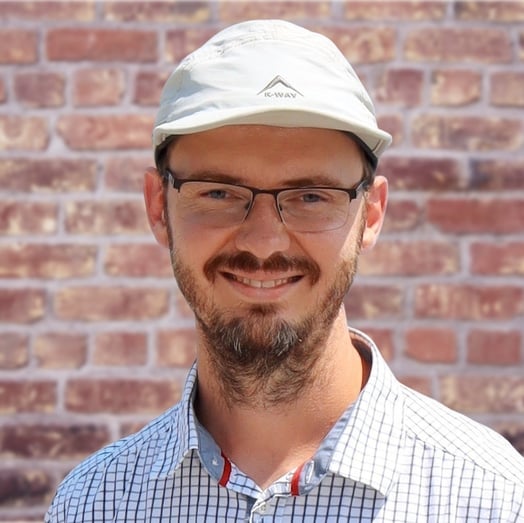
Bernardt Duvenhage
Verified Expert in Engineering
Machine Learning Developer
Bernardt is passionate about developing technology that fundamentally improves lives and broadens our knowledge. He led teams and developed software for computer vision, natural language understanding, modeling and simulation, and computer graphics projects. Bernardt has experience programming in C++ and Python, using frameworks such as scikit-learn and PyTorch for machine learning and deep learning, transformers, TorchVision, CUDA, OpenGL, Open Scene Graph, OpenCV, and NLTK.
Portfolio
Experience
Availability
Preferred Environment
C++, Python, MacOS, Linux
The most amazing...
...project I've developed is a natural language understanding and computer vision service used to build conversational agents in low-resource languages.
Work Experience
Machine Learning Lead, Conversational AI Systems
Praekelt Consulting (Now called Helm)
- Developed a natural language processing and computer vision service to build task-oriented conversational agents for low-resource languages. Technologies include transformers, PyTorch, TorchVision, Flask-RESTful, and PostgreSQL.
- Created intent classification, sentiment, and entity extraction models that rely on a variety of deep learning and classical machine learning techniques to accommodate various languages. Used transformers, sklearn, PyTorch, and TensorFlow.
- Developed a machine vision-based quality assurance application with a machine vision camera interface. The technologies include TorchVision, Flask-RESTful, GeniCam, and React. Used deep transfer learning to improve sample efficiency of clients' data.
Research Group Leader | Principal Research Scientist
Council for Scientific and Industrial Research
- Developed a real-time image processing framework as well as image enhancement, target detection, object tracking, and state estimation algorithms.
- Developed software interfaces to hardware devices like cameras, pan-tilt-zoom systems, communication radios, and real-time clocks.
- Led the company's image processing team of full-time employees and students, published some papers, and helped with talent management and screening.
Senior Research Scientist, Optronic Sensor Systems
Council for Scientific and Industrial Research
- Developed models for a physically based optronics scene simulator. The models were developed in C++ and an in-house 3D modelling tool.
- Developed physically based renderers for the long and medium wave infrared bands. The full software and hardware accelerated renderers were developed in C++ and OpenGL with GLSL. The rendering algorithms ranged from simple to path tracing.
- Developed physically based renderers for the short wave (reflective) and visual bands. The software and hardware accelerated renderers were developed in C++ and OpenGL with GLSL. The rendering algorithms ranged from simple to path tracing.
Senior Research Scientist, Modelling and Simulation
Council for Scientific and Industrial Research
- Developed a faster than real-time distributed modelling and simulation framework for wargaming type simulations. The simulation framework was implemented in C++ and employed TCP communication between the nodes.
- Developed vehicle and equipment models for wargaming type simulations. The models ranged from behavioural to physically based and were implemented in C++.
- Developed a 3D simulation viewer and analysis tool using Open Scene Graph and OSGEarth.
Experience
A Natural Language Understanding and Computer Vision Cloud Service
Real-time Image Processing Framework
Physically-based Path Tracing Renderer
Skills
Languages
Python, C++, GLSL, Assembly
Libraries/APIs
PyTorch, REST APIs, TensorFlow, Flask-RESTful, OpenCV, OpenGL, Scikit-learn, Natural Language Toolkit (NLTK), NumPy, Pandas
Platforms
Linux, MacOS, Google Cloud Platform (GCP), NVIDIA CUDA
Other
NLU, Computer Graphics, Machine Learning, Computer Science, Artificial Intelligence (AI), Natural Language Processing (NLP), Neural Networks, Text Classification, Image Classification, AI Design, GPT, Generative Pre-trained Transformers (GPT), Computer Vision, Modeling, Google BigQuery, Data Analytics, Simulations, Facial Recognition, Facial Tracking, Video Capture, Image Recognition, Rendering, Visual Computing, Sentiment Analysis, Real-time Vision Systems, Leadership, GPU Computing, Mathematics, Physics, Molecular Biology, Hardware Development, Data Engineering, Deep Reinforcement Learning, Deep Learning, Natural Language Understanding (NLU), Embedded Software, Torchvision, Transformers, Image Processing, Hardware Drivers, Graphical User Interface (GUI), Ray Tracing, Algorithms, 3D Math, Deep Neural Networks, Generative Adversarial Networks (GANs)
Tools
BigQuery, OpenSceneGraph
Paradigms
Data Science
Storage
Google Cloud
Education
PhD in Computer Science
University of Pretoria - South Africa
Certifications
Deeplearning.ai NLP Specialization (In Progress: 3/4 Course Certificates Completed)
Coursera
Deep Reinforcement Learning for Enterprise Nanodegree
Udacity
Google Cloud Certified - Professional Data Engineer
Google Cloud
Deep Learning 5-course Specialization by Deeplearning.ai
Coursera
How to Work with Toptal
Toptal matches you directly with global industry experts from our network in hours—not weeks or months.
Share your needs
Choose your talent
Start your risk-free talent trial
Top talent is in high demand.
Start hiring